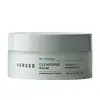What's inside
What's inside
 Key Ingredients
Key Ingredients

 Benefits
Benefits

 Concerns
Concerns

 Ingredients Side-by-side
Ingredients Side-by-side

Ethylhexyl Palmitate
EmollientCoco-Caprylate/Caprate
EmollientSynthetic Wax
AbrasivePolyglyceryl-10 Dioleate
EmulsifyingSorbitan Oleate Decylglucoside Crosspolymer
CleansingIsoamyl Cocoate
Glyceryl Citrate/Lactate/Linoleate/Oleate
EmulsifyingPolygonum Bistorta Root Extract
Skin ConditioningSalvia Hispanica Seed Oil
MoisturisingSimmondsia Chinensis Seed Oil
EmollientSorbitan Sesquioleate
EmulsifyingGlyceryl Laurate
EmollientAloe Barbadensis Flower Extract
EmollientMelia Azadirachta Leaf Extract
Skin ConditioningOcimum Sanctum Leaf Extract
Skin ConditioningMelia Azadirachta Flower Extract
Skin ConditioningWater
Skin ConditioningGlyceryl Caprylate
EmollientPolyglyceryl-3 Caprate
EmulsifyingPolyglyceryl-4 Cocoate
EmollientCoccinia Indica Fruit Extract
Skin ConditioningCorallina Officinalis Extract
Skin ConditioningSolanum Melongena Fruit Extract
Skin ConditioningCurcuma Longa Root Extract
MaskingOcimum Basilicum Flower/Leaf Extract
TonicGlycerin
HumectantPhenoxyethanol
PreservativePentylene Glycol
Skin ConditioningSodium Chloride
MaskingAlcohol
AntimicrobialTocopherol
AntioxidantEthylhexyl Palmitate, Coco-Caprylate/Caprate, Synthetic Wax, Polyglyceryl-10 Dioleate, Sorbitan Oleate Decylglucoside Crosspolymer, Isoamyl Cocoate, Glyceryl Citrate/Lactate/Linoleate/Oleate, Polygonum Bistorta Root Extract, Salvia Hispanica Seed Oil, Simmondsia Chinensis Seed Oil, Sorbitan Sesquioleate, Glyceryl Laurate, Aloe Barbadensis Flower Extract, Melia Azadirachta Leaf Extract, Ocimum Sanctum Leaf Extract, Melia Azadirachta Flower Extract, Water, Glyceryl Caprylate, Polyglyceryl-3 Caprate, Polyglyceryl-4 Cocoate, Coccinia Indica Fruit Extract, Corallina Officinalis Extract, Solanum Melongena Fruit Extract, Curcuma Longa Root Extract, Ocimum Basilicum Flower/Leaf Extract, Glycerin, Phenoxyethanol, Pentylene Glycol, Sodium Chloride, Alcohol, Tocopherol
Ethylhexyl Palmitate
EmollientCaprylic/Capric Triglyceride
MaskingCoco-Caprylate/Caprate
EmollientPolyglyceryl-6 Dicaprate
EmulsifyingSynthetic Wax
AbrasiveTocopherol
AntioxidantTocopheryl Acetate
AntioxidantEucalyptus Globulus Leaf Oil
PerfumingPersea Gratissima Oil
Skin ConditioningEugenia Caryophyllus Leaf Oil
MaskingSimmondsia Chinensis Seed Oil
EmollientPrunus Armeniaca Kernel Oil
MaskingSesamum Indicum Seed Oil
EmollientSclerocarya Birrea Seed Oil
HumectantCaprylyl Glycol
EmollientEugenol
PerfumingLimonene
PerfumingEthylhexyl Palmitate, Caprylic/Capric Triglyceride, Coco-Caprylate/Caprate, Polyglyceryl-6 Dicaprate, Synthetic Wax, Tocopherol, Tocopheryl Acetate, Eucalyptus Globulus Leaf Oil, Persea Gratissima Oil, Eugenia Caryophyllus Leaf Oil, Simmondsia Chinensis Seed Oil, Prunus Armeniaca Kernel Oil, Sesamum Indicum Seed Oil, Sclerocarya Birrea Seed Oil, Caprylyl Glycol, Eugenol, Limonene
 Reviews
Reviews

Ingredients Explained
These ingredients are found in both products.
Ingredients higher up in an ingredient list are typically present in a larger amount.
Coco-Caprylate/Caprate is created from fatty coconut alcohol, caprylic acid, and capric acid.
It is a lightweight emollient. Emollients create a thin barrier on the skin to trap moisture in. This helps keep your skin hydrated and soft.
Once applied, Coco-Caprylate/Caprate is absorbed quickly and leaves a silky feel.
Coco-Caprylate/Caprate may not be fungal acne safe.
Learn more about Coco-Caprylate/CaprateEthylhexyl Palmitate, also known as octyl palmitate, is created from 2-ethylhexyl alcohol and palmitic acid. It is a fatty acid ester.
The fatty acid content of Ethylhexyl Palmitate makes it an emollient. Emollients help soften and hydrate your skin by trapping moisture within.
Ethylhexyl Palmitate is also used to help improve the texture of cosmetics. It helps other ingredient dissolve in products and help disperse ingredients more evenly.
You'll likely find this ingredient in sunscreen, as it is often used to mix UV-blocking ingredients such as avobenzone and ethylhexyl triazone.
It can also help stabilize the fragrances in a product as a fragrance fixative.
Ethylhexyl Palmitate can be used to substitute mineral oil.
Due to its high fatty acid content, it may not be fungal-acne safe.
Learn more about Ethylhexyl PalmitateThis oil comes from the seeds of the desert shrub called Jojoba. It is more commonly known as jojoba oil, a non-comedogenic oil.
Jojoba oil does not contain fragrance and has many fatty-acids, making it a great soothing ingredient.
It also contains Vitamin E, a great moisturizing ingredient. Vitamin E is also an antioxidant and protects your skin against oxidative damage.
This ingredient humectant properties, meaning it helps draw moisture from the air. This helps keep your skin hydrated.
While jojoba has antibacterial properties, it is only able to kill some strains of bacteria.
Studies also show it helps in wound healing. In fact, Indigenous cultures have used jojoba as a moisturizer and to help treat burns for centuries.
Fun fact: Jojoba oil similar to natural human skin sebum, so it has a great effect on dry skin. It is also promising with helping to regulate sebum production.
Due to its fatty acid content, Jojoba oil may not be fungal acne safe. We recommend speaking with a professional if you have any concerns.
Learn more about Simmondsia Chinensis Seed OilSynthetic Wax is created from fossil fuels such as natural gas. It is used to enhance texture, adjust pH, and as an occlusive.
It may also be used as an abrasive ingredient to exfoliate the skin.
Synthetic Wax may not be fungal acne safe.
Learn more about Synthetic WaxTocopherol (also known as Vitamin E) is a common antioxidant used to help protect the skin from free-radicals and strengthen the skin barrier. It's also fat soluble - this means our skin is great at absorbing it.
Vitamin E also helps keep your natural skin lipids healthy. Your lipid skin barrier naturally consists of lipids, ceramides, and fatty acids. Vitamin E offers extra protection for your skin’s lipid barrier, keeping your skin healthy and nourished.
Another benefit is a bit of UV protection. Vitamin E helps reduce the damage caused by UVB rays. (It should not replace your sunscreen). Combining it with Vitamin C can decrease sunburned cells and hyperpigmentation after UV exposure.
You might have noticed Vitamin E + C often paired together. This is because it is great at stabilizing Vitamin C. Using the two together helps increase the effectiveness of both ingredients.
There are often claims that Vitamin E can reduce/prevent scarring, but these claims haven't been confirmed by scientific research.
Learn more about Tocopherol